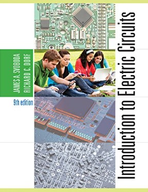Solution Found!
Consider the combination of circuit elements shown in Figure P 7.7-11. (a) Suppose
Chapter 7, Problem P7.7-11(choose chapter or problem)
Consider the combination of circuit elements shown in Figure P 7.7-11.
(a) Suppose element A is a 20-\(\mu\)F capacitor, element B is a 5-\(\mu\)F capacitor, and element C is a 20-\(\mu\)F capacitor. Determine the equivalent capacitance.
(b) Suppose element A is a 50-mH inductor, element B is a 30-mH inductor, and element C is a 20-mH inductor. Determine the equivalent inductance.
(c) Suppose element A is a 9-k\(\Omega\) resistor, element B is a 6-k\(\Omega\) resistor and element C is a 10-k\(\Omega\) resistor. Determine the equivalent resistance.
Questions & Answers
QUESTION:
Consider the combination of circuit elements shown in Figure P 7.7-11.
(a) Suppose element A is a 20-\(\mu\)F capacitor, element B is a 5-\(\mu\)F capacitor, and element C is a 20-\(\mu\)F capacitor. Determine the equivalent capacitance.
(b) Suppose element A is a 50-mH inductor, element B is a 30-mH inductor, and element C is a 20-mH inductor. Determine the equivalent inductance.
(c) Suppose element A is a 9-k\(\Omega\) resistor, element B is a 6-k\(\Omega\) resistor and element C is a 10-k\(\Omega\) resistor. Determine the equivalent resistance.
ANSWER:
Step 1 of 5
For the given circuit, components and
are connected in series, and component
in parallel with them.
a)
In this case,the components represent capacitors.
Capacitance for series connection of and
:
=
=
=
